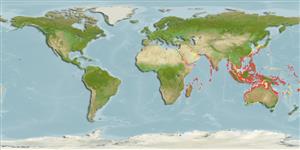Common names from other countries
Classification / Names / Names
Namen | Synonyme | Catalog of Fishes (gen., sp.) | ITIS | CoL | WoRMS
Environment: milieu / climate zone / depth range / distribution range
Ökologie
; tiefenbereich 1 - 37 m (Ref. 100968). Tropical
Indo-West Pacific: from central East Africa, to Sri Lanka; from Andaman and Nicobar Islands to eastern Melanesia; north to Japan and south to Queensland and New Caledonia.
Length at first maturity / Size / Gewicht / Alter
Maturity: Lm ? range ? - ? cm Max length : 5.0 cm SHL Männchen/unbestimmt; (Ref. 349); common length : 4.0 cm SHL Männchen/unbestimmt; (Ref. 349)
Mainly collected for shellcraft, where the species is abundant (Ref. 349). Found on shallow waters, on weeds and sand (Ref. 799). Also occurs in shallow subtidal waters (Ref. 349).
Life cycle and mating behavior
Geschlechtsreife | Fortpflanzung | Ablaichen | Eier | Fecundity | Larven
Members of the order Neotaenioglossa are mostly gonochoric and broadcast spawners. Life cycle: Embryos develop into planktonic trocophore larvae and later into juvenile veligers before becoming fully grown adults.
Poutiers, J.M. 1998. (Ref. 349)
IUCN Rote Liste Status (Ref. 130435)
CITES Status (Ref. 108899)
Not Evaluated
Not Evaluated
Bedrohung für Menschen
Harmless
Nutzung durch Menschen
| FishSource |
Tools
Mehr Information
Alter/GrößeWachstumLänge-GewichtLänge-LängeMorphologieLarvenDichte
Internet Quellen
Estimates based on models
Preferred temperature
(Ref.
115969): 24.7 - 29.1, mean 28.2 (based on 1088 cells).
Verwundbarkeit
Low vulnerability (10 of 100).
